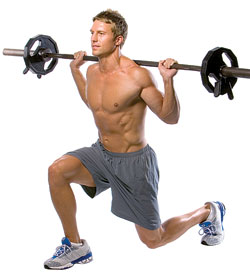.
Exercise Techniques
Like the site? Sign up for the FREE newsletter. I'll send a new article once or twice a month. Unsubscribe
anytime.
anytime.

About this Site l Contact l Free Newsletter l Subscribe to Rss Feed
Recommended Products l Fitness Store l Directly Fitness Blog
Recommended Products l Fitness Store l Directly Fitness Blog

How to Perform Barbell Lunges:


Proper Exercise Technique:
BARBELL LUNGES
Find this site useful? Click the donate button. Its greatly appreciated.
Think a friend might benefit from this page? Share it!
Think a friend might benefit from this page? Share it!
Note:
It is beneficial to first master lunges with dumbbells and then move on to using the barbell. Test your ability, strength, and coordination first by using only the barbell with no added weight to get a feel for the movement. Practice makes perfect.
• Bar should be racked at a height about 1/2 to 3/4 foot less than your
height
• Grip bar a little wider than shoulder width
• Bend at knees and assume a “squatting” position ready to press off
• Your front knee should extend, sending you back into the upright standing
position
• Keep good upright trunk and head posture and tight abdominals
• Repeat with other leg until desired repetitions are achieved
• Step back from rack far enough to lunge with plenty of room
• Make sure you have plenty of room on either side of you as well. This will
prevent hurting others that may be walking around you during this exercise.
• Maintain head and trunk upright posture
• Keep a tightened abdominal contraction
• Take a moderate step length forward with either leg (2-4 feet)
• Make sure you feel comfortable with the depth of your step as to not loose
balance with a very long step
• Slowly bend your front leg until it reaches at or below 90 degrees
• Rear leg should also passively bend to about 90 degrees when you do this
• Be sure not to lean forward! This can lead to injury and upright posture is the
key!
must be learned before attempting this exercise! Try looking at yourself in
the mirror while practicing with no added weight.
• This is a high intensity exercise as almost every major muscle is being
worked! Be sure to have lots of energy and focus when performing the
deadlift.
• Be sure to inhale on the way down and exhale on the way up! If you hold
your breath in you risk passing out in the middle of the movement due to
built up pressure in your body!
• This exercise will feel very unnatural to some and most fail at forearm
strength.
• If you don’t have good forearm strength it won’t matter how strong your legs
and back are. Strength your forearms if you feel they can’t hold the bar
efficiently.
• Use lifting chalk if you feel your grip could use a little boost. You can find it at the Fitness
Store for great deals.
• If you progress to heavier sets, I recommend you use a belt to prevent injury
as it provides extra stability and support. I recommend you only use it for
those heavy sets as overusing a belt can actually lead to core weakness.
Simply do without the belt for lighter sets leading up to the heavy sets at which time you can put the belt on. This will keep you safe without having the core weakness associated with using a belt.
The best belts are the thick powerlifting style belts that are just as wide in the front as they are in the back. This allows you to push your stomach against the belt and provide more support for the lower back. I suggest you avoid the thin weight lifting belts that are pretty common in department stores. If you are interested in weight lifting belts you can find them in the Fitness Store.
It is beneficial to first master lunges with dumbbells and then move on to using the barbell. Test your ability, strength, and coordination first by using only the barbell with no added weight to get a feel for the movement. Practice makes perfect.
About Lunges:
The lunge is a full lower body workout utilizing many major muscle groups. Balance is often a safety concern with this exercise and practice without a barbell is encouraged using only your body weight to improve balance and coordination. Variations in step length and step angle can create a wide variety of lunge techniques.Muscles Used in the Lunge Exercise:
Major muscle groups utilized during the lunge exercise are: Gluteus maximus, Gluteus medius, Gluteus Minimus, Quadriceps, Hamstrings, Tensor Fascia Latae, and other hip flexor muscles. Special emphasis is placed on the quadriceps muscles as these control the motion both eccentrically and concentrically.Starting Position:
• Begin by lining the back of your neck with the bar as it rest on your shoulders• Bar should be racked at a height about 1/2 to 3/4 foot less than your
height
• Grip bar a little wider than shoulder width
• Bend at knees and assume a “squatting” position ready to press off
Upward Phase:
• Press off the ground in a forceful manner with the front foot using sole of foot• Your front knee should extend, sending you back into the upright standing
position
• Keep good upright trunk and head posture and tight abdominals
• Repeat with other leg until desired repetitions are achieved
Downward Phase:
• Carefully press off the ground slightly to get bar off rack• Step back from rack far enough to lunge with plenty of room
• Make sure you have plenty of room on either side of you as well. This will
prevent hurting others that may be walking around you during this exercise.
• Maintain head and trunk upright posture
• Keep a tightened abdominal contraction
• Take a moderate step length forward with either leg (2-4 feet)
• Make sure you feel comfortable with the depth of your step as to not loose
balance with a very long step
• Slowly bend your front leg until it reaches at or below 90 degrees
• Rear leg should also passively bend to about 90 degrees when you do this
• Be sure not to lean forward! This can lead to injury and upright posture is the
key!
Lunge Tips:
• This movement is very unnatural to most and will not come easily. Formmust be learned before attempting this exercise! Try looking at yourself in
the mirror while practicing with no added weight.
• This is a high intensity exercise as almost every major muscle is being
worked! Be sure to have lots of energy and focus when performing the
deadlift.
• Be sure to inhale on the way down and exhale on the way up! If you hold
your breath in you risk passing out in the middle of the movement due to
built up pressure in your body!
• This exercise will feel very unnatural to some and most fail at forearm
strength.
• If you don’t have good forearm strength it won’t matter how strong your legs
and back are. Strength your forearms if you feel they can’t hold the bar
efficiently.
• Use lifting chalk if you feel your grip could use a little boost. You can find it at the Fitness
Store for great deals.
• If you progress to heavier sets, I recommend you use a belt to prevent injury
as it provides extra stability and support. I recommend you only use it for
those heavy sets as overusing a belt can actually lead to core weakness.
Simply do without the belt for lighter sets leading up to the heavy sets at which time you can put the belt on. This will keep you safe without having the core weakness associated with using a belt.
The best belts are the thick powerlifting style belts that are just as wide in the front as they are in the back. This allows you to push your stomach against the belt and provide more support for the lower back. I suggest you avoid the thin weight lifting belts that are pretty common in department stores. If you are interested in weight lifting belts you can find them in the Fitness Store.
Here is a video to assist you in learning the proper form for Lunges:
Continue to learn more about how to exercise: Proper Exercise Techniques
BARBELL LUNGES
